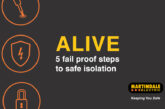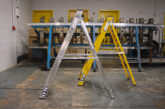
This article from the experts at NICEIC will remind contractors of the need to apply due diligence when installing cables in thin walls and/or partitions, especially where there is access to both sides.
A cable embedded in a wall or partition at a depth of less than 50 mm from the surface can be vulnerable to penetration by nails, screws and the like, leading to a risk of electric shock or fire. It is therefore important that cable routes are properly planned and adequate measures are taken to ensure that cables are installed to meet the requirements for protection against impact and, in particular, those of Regulation Group 522.6 of BS 7671.
Where a wall or partition contains significant metallic parts, such as a metal-framed structure (see Fig 1), there is a greater risk that, as a result of damage to a cable, all the metallic structure of the wall or partition may become live. For this reason, BS 7671 treats walls or partitions containing significant metal parts differently to those with a traditional construction using timber studding.

General requirements for positioning and protection of cables
Regulation 522.6.202 of BS 7671 deals with the requirements for cables installed in a wall or partition of traditional construction (for example brick, block or timber) at a depth of less than 50 mm from the surface of the wall or partition.
Where the position of an accessory, point or item of switchgear can be determined from the reverse side of a wall or partition less than 100 mm thick, then the zone also extends to the reverse side.
Cables intended to operate at low voltage not incorporating mechanical protection, or not provided with such a means of mechanical protection sufficient to satisfy the requirements of regulation 522.6.204, must be protected by an RCD with the characteristics specified in regulation 415.1.1.
Prescribed zones in accordance with 522.6.202
When planning cable routes and installing cables within a prescribed zone, consideration must be given to both sides of the wall or partition, especially where the thickness is less than 100 mm and there is access to both sides.
Consider a building, for example, where proprietary panels less than 100 mm thick are used to form a partition wall within a room and where access is available to both sides. Such panels may incorporate vertical service routes (channels for cables or pipes), positioned midway between the surfaces.
Cables installed in these routes will not be more than 50 mm from either surface of the partition. Therefore, unless an accessory, point or item of switchgear is mounted within a prescribed zone, such as:
• within 150 mm of the top of the wall or partition; or
• within 150 mm of an angle formed by two adjoining walls or partitions; then a cable not meeting the requirements of regulation 522.6.204 must be routed to the point, accessory or item of switchgear, only in a zone running horizontally or vertically, as shown in yellow in Fig 2.

Note: This zone will also extend to the reverse side of the wall or partition, where the position of the accessory, point or item of switchgear can be determined from the reverse side.
Satisfying Regulation 522.6.202 by other methods
Where a cable is installed outside a prescribed zone, as shown in Fig 2, the requirements of regulation 522.6.202 may also be met by complying with one or more of the methods given in regulation 522.6.204, including:
Cables incorporating an earthed armour or metal sheath
Where a cable such as mineral insulated copper sheathed or steel wire armoured is employed, the earthed metallic sheath or armouring of the cables is required to meet the requirements for a protective conductor for the circuit concerned relating to electrical continuity and cross-sectional area.
Cables enclosed in earthed conduit, trunking or ducting
In principle, an earthed steel conduit, trunking or ducting utilises the same method of protection as a cable with an earthed metallic covering and, by construction, provides a higher degree of protection against mechanical damage.
Cables with mechanical protection sufficient to prevent penetration
Cables may be provided with mechanical protection sufficient to prevent the penetration of the cable by nails, screws and the like. The mechanical protection, normally metal and approximately 3 mm thick, need not be earthed.
However, in some circumstances, such mechanical protection may not be sufficient to ensure that a cable cannot be penetrated, for example where the fixing methods of other trades employ nail guns.
Mechanical protection would therefore be unacceptable, as metallic capping and often proprietary protective plates would not provide sufficient protection against such an impact.
Cables forming part of a SELV or PELV circuit
A cable forming part of a SELV or PELV extra-low-voltage circuit meeting the requirements of regulation 414.4 may be used as an alternative to minimising the risk of electric shock in the event of impact to the cable.
However, the cable must still be installed in a manner that minimises damage from impact, abrasion, penetration, tension or compression during the installation or maintenance process, whilst also satisfying the requirements of regulation 522.6.202.
Additional protection by means of an RCD
Additional protection by means of an RCD with a rated residual operating current (IΔn) not exceeding 30 mA (415.1.1) must be provided in all cases where a cable not complying with regulation 522.6.204 is installed in a wall or partition at a depth of less than 50 mm from the surface.
It should be remembered that, as well as being provided with additional protection by an RCD, a cable not complying with regulation 522.6.204 must still be installed in the ‘prescribed zones’ as described previously and given in indent (I) of regulation 522.6.202.
Additional protection to cables installed in a wall or partition including metallic parts
Regulation 522.6.203 requires a cable installed at any depth in a wall or partition with internal metallic parts, excluding fixing items, such as nails, screws and the like to be provided with either:
• additional protection by an RCD with the characteristics described previously, or
• one of the measures described in regulation 522.6.204.
In addition, regulation 522.6.203 also requires a cable installed at a depth of 50 mm or less from the surface of a wall or partition with internal metallic parts, to meet the “prescribed zone” requirements of regulation 522.6.202.
Other considerations to protect cables against damage
Where cables fixed on walls or partitions will subsequently be concealed by “wet” building materials such as plaster or mortar, consideration should be given to the provision of a protective material such as capping to minimise the risk of damage caused by trowels and the like during the application process (522.8.1).
Summary
In order to minimise the risk of impact and the resultant danger, cables embedded in walls and/or partitions at a depth of less than 50 mm from the surface must be installed in accordance with the applicable requirements of BS 7671, and in particular, those of regulation group 522.6.
Get more details about NICEIC registration here








